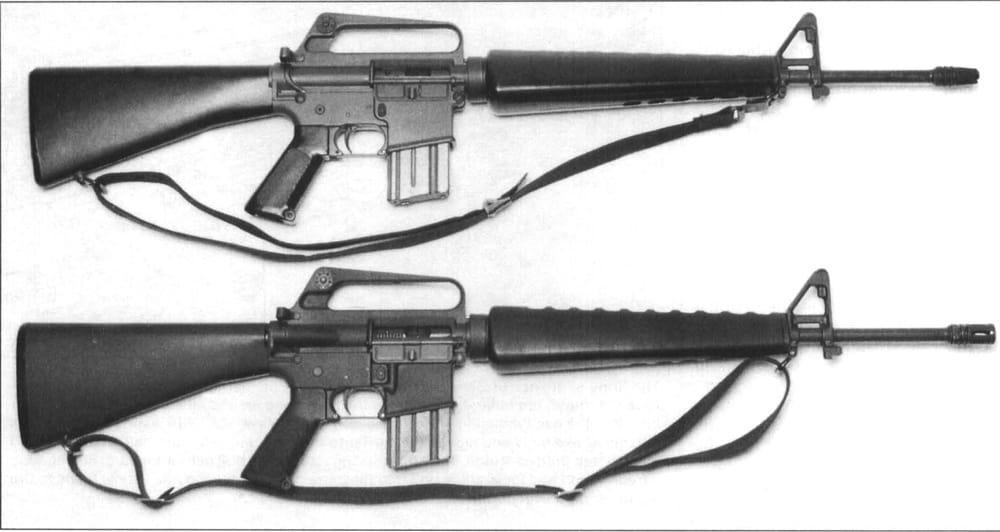During World War II, American soldiers had the world’s best rifle, the M1 Garand – a highly reliable .30 caliber semi-automatic firearm, at a time when the rest of the world’s armies relied on bolt action rifles. The M1 performed with distinction, and general George S. Patton called it “the greatest battle implement ever devised“. By war’s end, military establishments were working on greatly increasing the issue of semi and automatic small arms to their forces as standard issue. Within five years, the M1 had itself become outdated.
The Korean War demonstrated that the Garand, cutting edge just a few years earlier, was now obsolete, its chief drawbacks being excessive weight, limited ammunition capacity, and lack of automatic fire. It was replaced with the M14 rifle – a souped up M1 upgrade, with a 20 round magazine and capable of automatic fire. While a vast improvement over the Garand, another Asian land war, this one in Vietnam, revealed that the M14 also suffered some serious drawbacks. So it was replaced with a new, cutting edge rifle, the M16. The M16 would eventually become one of the world’s greatest standard issue military rifles, and its progeny are still standard issue for American troops, more than half a century later. However, when first introduced, the M16 had some serious teething problems. They gave the new rifle a poor reputation and made it highly unpopular, until its kinks were finally worked out.

The Transition to the M16 Rifle
When the M14 first saw action in Vietnam, significant drawbacks emerged. For one, while the rifle was a stable and accurate platform when firing single rounds in semi automatic mode, it was virtually uncontrollable when firing on full auto. For another, while its 7.62mm NATO rounds were more powerful and could reach farther than the rounds of the AK-47 wielded by the American soldiers’ opponents, the M14’s cartridges were heavier. That weight meant that M14 users could carry fewer bullets, pound for pound, than their AK-47 wielding adversaries.
Worse, the disadvantages caused by the heavier weight was not balanced out by practical advantages. In most encounters, the M-14 rifle’s longer range was seldom needed in Vietnam, where there were relatively few wide open fields of fire, and where the rugged terrain and vegetation meant that most engagements took place at short to medium distances. Being able to shoot somebody at 500 yards, which the M-14 could reliably do with iron sights (and at 900 yards or more with a scope), was superfluous when most American troops seldom saw an enemy beyond 100 or 200 yards.
An alternative and older rifle, the M2 Carbine, offered a higher rate of fire than the M-14, but its bullets were underpowered compared to the AK-14, which generally outclassed it coming and going. An alternative was needed, and the AK-47, with its intermediate cartridge, pointed the way forward. To stand on an equal footing with the communists, American soldiers needed a rifle that could fire a round that was more powerful than a carbine or submachine gun, but that was lighter than a high velocity rifle round, whose long range was seldom needed in most engagements.

The debate was thus between greater killing or stopping power with a more accurate and longer range powerful weapon, or more bullets to keep an enemy’s head down at shorter range, with a higher chance of hitting and at least slowing him down. The debate led military authorities to rethink a rifle they had rejected in the 1950s: the Armalite AR-15. Developed in response to a US Army request, the AR-15 weighed 6 pounds with a 20 round magazine, fired .223 inch caliber (5.56 mm) rounds that could penetrate an American helmet at 500 yards, and matched or exceeded the wounding capacity of a .30 round. The Army turned it down, and stuck with the M14.
Vietnam forced a reconsideration, and early in 1963, Secretary of Defense Robert McNamara decided that the AR-15 was the superior rifle, and ordered a halt to M14 production. After minor modifications, the AR-15 entered US military service as the Rifle, Caliber 5.56 mm, M16. Composed of hard anodized aluminum alloys, fiberglass, and steel, the new rifle was significantly lighter than the M14, and the lighter weight of M16 and of its cartridges allowed soldiers to carry more ammunition. However, although superior on paper and during the testing that led to its adoption, the new rifle demonstrated some serious drawbacks when it first went into combat.

